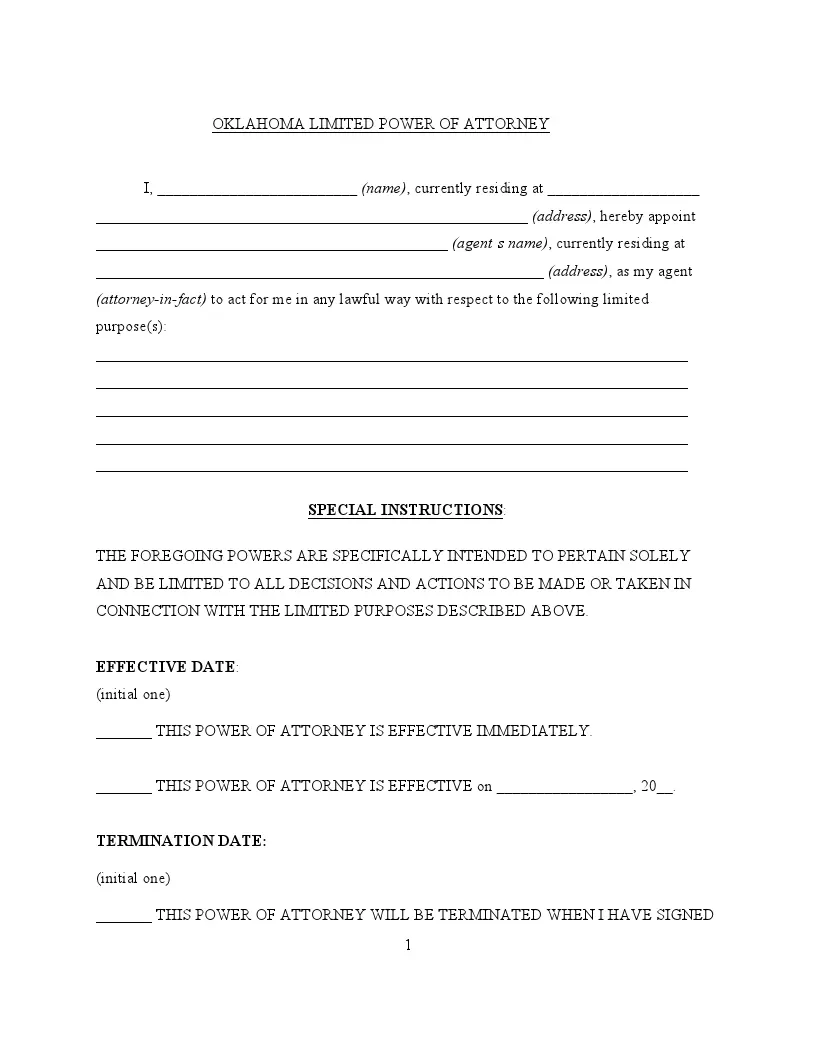Oklahoma Limited Power of Attorney Form
The Oklahoma limited power of attorney is a legal document that grants someone else, known as an agent or attorney-in-fact, the authority to act on behalf of the principal (the person creating the power of attorney) in specific situations. This type of power of attorney is “limited” because it restricts the agent’s authority to certain acts, periods, or circumstances, as specified in the document.
For instance, a limited power of attorney could enable the agent to oversee real estate dealings or control financial accounts only when the principal is abroad or unable to act. This arrangement allows the principal to customize the agent’s powers to address particular requirements or responsibilities, providing a versatile means to handle personal matters without giving away extensive authority.
You may use Oklahoma power of attorney forms if you need to appoint a trusted person to manage your affairs.

Build Your Document
Answer a few simple questions to make your document in minutes
Save and Print
Save progress and finish on any device, download and print anytime
Sign and Use
Your valid, lawyer-approved document is ready
In Oklahoma, establishing a limited power of attorney is governed by specific signing requirements and laws. Title 58, Chapter 29 of the Oklahoma Statutes, outlines the necessary procedures and definitions to ensure that a power of attorney is legally valid. The main points of the legislation are:
- An “agent” refers to any person designated to act on behalf of the principal, including original agents, coagents, successor agents, and delegates (58 O.S. § 3002).
- To authenticate the document, it must be signed by the principal and lawfully notarized (58 O.S. § 3005).
These requirements ensure the document legally authorizes the agent while protecting the principal’s interests. Notarization verifies the principal’s identity and voluntary decision to grant authority to the agent, thereby preventing potential fraud and misunderstandings.
Oklahoma Limited Power of Attorney Form Details
| Document Name | Oklahoma Limited Power of Attorney Form |
| Other Name | Oklahoma Special Power of Attorney |
| Relevant Laws | Oklahoma Statutes, Sections 58-3001 to 58-3045 |
| Avg. Time to Fill Out | 8 minutes |
| # of Fillable Fields | 32 |
| Available Formats | Adobe PDF |
Filling Out Oklahoma Limited POA
When completing a limited power of attorney form in Oklahoma, you must follow the specified guidelines to ensure the document is legally valid and accurately represents your intentions.
1. Personal Details
Begin by entering your full legal name and current residential address in the designated areas at the top of the form. Ensure that you provide complete and accurate details, as these establish your identity as the principal granting the power of attorney.
2. Naming Your Attorney-in-Fact
In the section provided, write the full name and residential address of the person you appoint as your agent (attorney-in-fact). This person will have the authority to act on your behalf. Ensure that the individual is someone you trust, as they will make decisions in your stead.
3. Specify Limitations
Clearly describe the specific powers you are granting to your agent. It might include handling financial transactions, making medical decisions, or managing real estate. Be as detailed as possible to avoid ambiguity regarding your agent’s roles and responsibilities.
4. Timing of Authority
Decide when the power of attorney will become effective and when it will terminate. You can choose whether it will be effective immediately or commence on a specified future date. Similarly, termination can be set to a specific date, upon a written revocation, or when you are determined to be incapacitated. You must initial next to your choice for the effective and termination dates.
5. Alternative Arrangements
If your primary agent cannot serve or continue serving for any reason, you may appoint a successor agent by entering their name and address in the designated area. This step ensures that your affairs remain in trusted hands without interruption.
6. Legal Validation
After reviewing the form to ensure all information is correct and reflects your wishes, sign and date the document in the presence of a notary public. This step is crucial as it validates the form legally.
7. Official Acknowledgment
The notary public will verify your identity, witness your signature, and then complete the acknowledgment section. This part includes the notary’s official seal and signature, which are necessary to certify the document under Oklahoma law.
